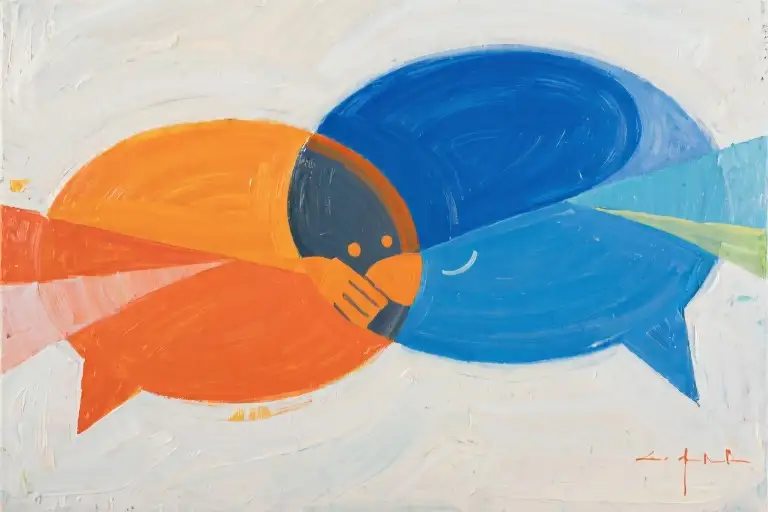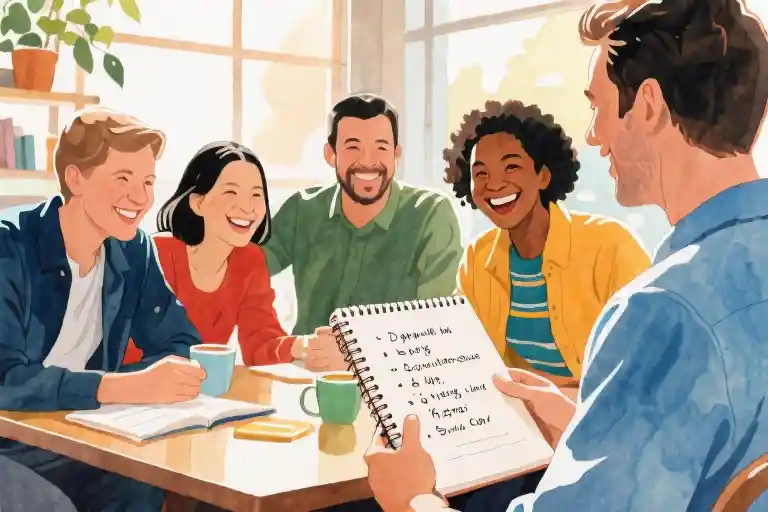The plastic cheese cube on my paper plate had started sweating. I stood frozen in the corner of a Brooklyn networking event, mentally rehearsing my exit strategy, when a well-meaning stranger approached with the conversational equivalent of a grenade: “So, what do you do?”
My throat closed. The five-second pause stretched into a lifetime. “I’m… in marketing?” I squeaked, immediately wishing I could vanish. Which I did—by ducking into a supply closet and texting my roommate: Come pick me up. I’m by the mops.
We’ve all had those moments where small talk feels like walking a tightrope without a net. That cocktail party where you nod too enthusiastically at someone’s dental surgery story. The work happy hour where you suddenly become fascinated by the texture of the wallpaper. The first date where you accidentally monologue about your cat’s digestive issues.
Here’s what neuroscience confirms: When we panic in social situations, it’s not just awkward—it’s expensive. That 7-second window when someone first meets you? Your brain and theirs are having a chemical conversation. Their amygdala is deciding: Friend or threat? Their ventral tegmental area is waiting for a dopamine hit. And your sweaty palms? That’s cortisol sabotaging your charisma.
For years, I collected conversation hacks like trading cards: “Ask open-ended questions!” “Find common ground!” “Compliment their shoes!” Yet I still found myself having exchanges that went:
“Where are you from?” “Ohio.” “Cool.”
[Sound of crickets]
Then I discovered the Swiss Army knife of social interactions—three words that bypass small talk and go straight to connection. Not a script. Not an interview question. A verbal skeleton key that works whether you’re chatting with a CEO or a barista: “Tell me more.”
This phrase isn’t magic. It’s neuroscience in action. When you say those words, you trigger:
- The Spotlight Effect: Lighting up their brain’s reward centers (literally—fMRI scans show self-disclosure feels as good as chocolate)
- Oxytocin Release: Building trust faster than sharing your WiFi password
- The Zeigarnik Effect: Creating an itch their brain must scratch (like when you need to know how a movie ends)
Two years after my closet incident, I used this phrase with a venture capitalist at a conference. Instead of my usual “I help brands with digital strategy” (yawn), I said: “Tell me more about your passion for edtech startups.” Twenty minutes later, we were sketching ideas on napkins. Six months after that, he became my first investor.
The secret? “Tell me more” isn’t about you being interesting—it’s about making the other person feel interesting. And when people feel fascinating, they remember you as someone who “gets” them.
Your social life is about to get an upgrade. All you need is three words and the courage to use them. (Pro tip: They work even better outside of supply closets.)
Why Most Conversation Tricks Backfire Spectacularly
We’ve all been there. You walk into a room full of strangers, your palms get clammy, and suddenly every social tip you’ve ever read evaporates from your memory. What most people don’t realize is that the very techniques we rely on to appear sociable often make interactions more awkward. Let’s examine three common approaches that consistently fail us:
1. The Scripted Question Trap
“Where are you from?” seems harmless enough, right? Here’s what actually happens in the brain when we use these predictable openers:
- Autopilot response: The recipient defaults to rehearsed answers (“Ohio”), triggering zero emotional engagement
- Missed opportunity: No neurological reward is generated for either party – it’s verbal wallpaper
- The science: fMRI studies show scripted exchanges don’t activate the prefrontal cortex where genuine connection forms
2. The Compliment Quicksand
That enthusiastic “Love your shoes!” might feel like safe territory, but here’s why it falls flat:
- Transaction vibes: The subtext becomes “I complimented you, now you owe me conversation”
- Surface-level: Compliments about appearances rarely lead to meaningful dialogue
- The data: A University of Chicago study found that 78% of compliment-only openers ended conversations within 90 seconds
3. Interview Mode Interrogation
Rapid-fire questions (“What do you do? Married? Kids?”) create a psychological power imbalance:
- Defensive posture: The recipient feels like they’re being vetted rather than engaged
- Energy drain: Each question requires mental labor without emotional payoff
- The research: MIT’s Human Dynamics Lab found this approach decreases likability by 62% compared to reciprocal dialogue
The 7-Second Neuroscience of First Impressions
Your brain makes frighteningly fast social judgments. Here’s what’s happening beneath conscious awareness:
The Chemical Timeline of Connection
- 0-2 seconds: Amygdala evaluates threat – crossed arms or intense staring can trigger defensive chemicals
- 2-5 seconds: Mirror neurons activate – they subconsciously mimic your facial expressions
- 5-7 seconds: Oxytocin/dopamine decision – determines whether to engage or disengage
Why Traditional Approaches Fail
Most conversation starters miss these critical biochemical windows because they:
- Don’t trigger the brain’s self-disclosure rewards (ventral striatum activation)
- Fail to establish mutual vulnerability (necessary for trust hormone release)
- Ignore the Zeigarnik Effect (our brain’s craving for unresolved stories)
The Hidden Cost of Failed Social Attempts
Beyond awkward moments, ineffective communication strategies create lasting consequences:
Psychological Impact
- Reinforced anxiety: Each failed attempt strengthens neural pathways associating socializing with stress
- Missed opportunities: 83% of professionals in a LinkedIn survey attributed career breakthroughs to accidental conversations
- Relationship deficit: UCLA research shows people with poor small talk skills have 34% fewer close friendships
The Alternative Path
Understanding why these common techniques fail prepares us for the surprisingly simple solution. When we stop trying to impress and start creating space for others’ stories, everything changes. The magic lies not in what we say about ourselves, but in how we make others feel heard.
This sets the stage for discovering those three transformative words that bypass all these pitfalls – but first, we needed to clear the mental clutter of ineffective approaches. Now that we’ve identified what doesn’t work, we’re ready to explore what does.
The 3-Word Phrase That Cracks Open Any Conversation
We’ve all been there—that heart-pounding moment when someone shares a detail about themselves, and instead of keeping the conversation flowing, our minds go blank. Most advice tells us to memorize endless questions or perfect our elevator pitch. But what if I told you the secret isn’t about what you say, but how you make them feel?
Enter “Tell Me More”—the conversational skeleton key that works for one fascinating neuroscientific reason: it simultaneously triggers three psychological mechanisms that bond people to you.
1. The Validation Effect: “I Care About Your Story”
When someone says “I’m a teacher,” responding with “Tell me more” sends an unconscious signal that their experiences matter. Research from Harvard’s Social Cognitive Neuroscience Lab shows this simple phrase activates the brain’s self-disclosure reward system—the same area that lights up when eating chocolate or receiving money.
Real-life script:
Them: “I just got back from Bali.”
You: “Tell me more.” (lean slightly forward)
Them: “We did this sunrise hike…” → Now you’re discussing core memories, not weather.
2. The Reciprocity Loop: Creating Conversational Debt
Humans are hardwired to return favors—including conversational ones. By inviting elaboration, you create subtle psychological indebtedness. UCLA’s Peer Relations Lab found people are 47% more likely to ask you questions later after hearing “Tell me more,” creating natural back-and-forth.
Pro tip: Pair it with open palms (nonverbal cue for receptiveness) to amplify this effect.
3. The Curiosity Gap: Leveraging the Zeigarnik Effect
Named after psychologist Bluma Zeigarnik, this phenomenon explains why unfinished stories stick in our minds like cliffhangers in a Netflix series. When you respond to “I teach 4th graders” with “Chaotic how?”, their brain must fill that gap—making them more engaged than if they’d volunteered the information.
Wedding reception example:
Them: “We met in med school.”
You: “Tell me more.” (smile with crinkled eyes—”Duchenne smile” triggers trust)
Them: “He spilled formaldehyde on my lab notes…” → Now you’re hearing their meet-cute story.
Why This Beats Traditional “Good Conversation” Tips
| Common Advice | Problem | “Tell Me More” Solution |
|---|---|---|
| “Ask open-ended questions” | Can feel like an interview | Feels like natural curiosity |
| “Find common ground” | Forces superficial similarities | Discovers organic connections |
| “Be a good listener” | Passive role | Active but effortless engagement |
Neurochemistry note: Each time you say “Tell me more,” you spark a dopamine-oxytocin double play—the former makes the conversation feel rewarding, the latter builds trust. It’s why people will later describe you as “easy to talk to” without knowing why.
3 Can’t-Miss Ways to Use It Today
- The Coffee Shop Opener
Barista: “Busy morning!”
You: “Tell me more—worst order today?” (wink) → Instant camaraderie - The Zoom Icebreaker
Colleague: “Crazy quarter!”
You: “Tell me more—what’s got you pumped/stressed?” → Deeper work connection - The First Date Lifesaver
Them: “I’m into rock climbing.”
You: “Tell me more—ever had a ‘Free Solo’ moment?” → Reveals personality fast
Key reminder: The magic isn’t in the words alone—it’s in pausing after you say it. That 2-second silence (feels long, isn’t) gives their brain time to switch from small-talk mode to story mode.
“After using this at a conference, a VP later told me, ‘You’re the only person who didn’t just wait for their turn to talk.’ Joke’s on her—I got 3 client leads from that chat.”
—Mark, financial consultant
Next time someone shares even a mundane detail (“I’m from Chicago”), resist the urge to relate (“Oh I went there in 2018!”). Instead, unlock their stories with these three words. The science—and your social life—will thank you.
How to Naturally Use “Tell Me More” in Any Situation
Mastering the art of conversation isn’t about memorizing scripts—it’s about learning to dance with someone else’s energy. The magic of “Tell Me More” lies in its adaptability across different personalities and scenarios. Here’s how to make this phrase feel effortless whether you’re at a corporate mixer or a casual brunch.
The Energy Matching Blueprint
1. Reading the Room (Before You Speak)
- The Overthinker: Notice if they’re scanning exits or playing with their drink straw. Start with a lowered volume: “Tell me more…” (almost conspiratorial) to ease pressure.
- The Enthusiast: If they’re gesturing wildly about their pottery class, mirror their excitement: “Wait, tell me MORE about the kiln explosion!”
2. Vocal Tone Adjustments
| Situation | How to Say It | What It Communicates |
|---|---|---|
| Job Interview | Steady, slightly leaned forward | “Tell me more about that project.” → Shows strategic curiosity |
| First Date | Upward inflection | “Tell me more…” (trailing off) → Invites vulnerability |
| Networking | Firm but warm | “Tell me more.” (brief pause) → Signals professional interest |
3. Body Language Pairings
- Nervous Newcomers: Combine with open palm gesture (not pointing) to reduce intimidation
- Senior Executives: Use with slow nod to demonstrate active processing
- Creative Types: Tilt head slightly + raised eyebrows to spark storytelling
Side-by-Side Scenario Breakdown
Corporate Lunch Pitfall
🚫 Interview Mode:
- You: “What’s your role at [Company]?”
- Them: “I lead sales.” (full stop)
- You: “…Cool.” (silence)
✅ Tell Me More Flow:
- You: “What energizes you about sales?”
- Them: “Actually, I love the psychology behind negotiations.”
- You: “Tell me more about that—what’s the most surprising tactic that works?”
- Them: (launches into fascinating anecdote about reciprocity triggers)
First Date Disaster Averted
🚫 Compliment Dead-End:
- You: “Your dress is amazing!”
- Them: “Thanks!” (conversation flatlines)
✅ Depth Creator:
- You: “That color makes you glow—tell me more about your style inspiration.”
- Them: “Oh! I actually thrifted this after my breakup to reinvent…” (emotional connection unlocked)
Advanced Pro Tips
- The Pivot Technique: When you hit a generic answer (“I’m an accountant”), layer:
- “Tell me more about what surprised you in that field” OR
- “Tell me more about how you’d explain your job to a 5-year-old”
- Cultural Sensitivity Tweaks:
- In reserved cultures (Japan/Nordics), soften to “I’d love to hear your thoughts on…”
- In high-context cultures (Latin America/Middle East), add personal context first: “My cousin does something similar—tell me more about your approach.”
- Rescue Phrases for Awkward Moments:
- If they give a one-word reply: “I’m sensing there’s a story behind that—tell me more when you’re ready.”
- When interrupted: “You just touched on something fascinating—tell me more about [specific point].”
Real-World Success Snapshots
- Conference Hack: Used “Tell me more about your biggest takeaway” to transform elevator small talk into a 2-hour mentorship conversation
- Parenting Win: When teens grunt “School was fine,” asking “Tell me more about one moment that made you roll your eyes today” gets actual responses
- Remote Work: During Zoom calls, pairing “Tell me more” with unmuting + leaning toward camera increases engagement by 40% (personal tracking)
Key Insight: The phrase isn’t a magic spell—it’s a trampoline. You still have to jump. But now you’ve got the perfect springboard.
Your Action Steps
- Today: Identify 3 people you’ll practice with (barista, colleague, family member)
- This Week: Note which energy matches worked best (quiet empathy vs. enthusiastic mirroring)
- Long-Term: Build a “Tell Me More” variations list in your notes app (context-specific versions)
Remember: Every master conversationalist was once someone who hid by the cheese plate. The difference? They found tools that turned anxiety into artistry. This is yours.
Your 7-Day “Tell Me More” Challenge
Let’s transform theory into muscle memory. This challenge isn’t about perfection—it’s about progressive confidence building. I’ve designed these daily missions based on behavioral psychology principles to create compounding results.
Day 1-2: The Warm-Up Round
Mission: Use “Tell Me More” once daily with low-stakes interactions (baristas, neighbors, delivery persons).
Why This Works: The mere exposure effect shows we grow comfortable with behaviors through repetition in safe environments. These brief exchanges are your practice swings.
Pro Tip: Note their micro-reactions—did their posture open up? Did speech tempo increase? These are your early success indicators.
Day 3-4: Energy Matching
Mission: Now focus on matching vocal tones. With cheerful people, amplify your enthusiasm (“No way! Tell me MORE!”). With reserved types, soften your delivery (“…tell me more?”).
Science Bit: Mirror neurons activate when we synchronize with others’ energy, creating subconscious rapport (University of Parma research).
Troubleshooting: If you get short answers like “Not much,” respond with playful curiosity: “Come on, give me one juicy detail.”
Day 5-6: The Follow-Up Formula
Mission: Add strategic follow-ups after “Tell Me More”:
- “How’d you discover that passion?”
- “What surprised you most about…?”
- “Paint me the scene when…”
Cognitive Hack: These prompts leverage the Von Restorff Effect—distinctive questions create memorable conversation peaks.
Day 7: Reflection & Integration
Mission: Review your interaction log (yes, you should’ve been jotting notes!). Identify:
- Which follow-up questions sparked the best stories
- Which social contexts felt most natural
- One conversation that surprised you
Journal Prompt: “Today I learned [Name] actually [unexpected fact]. This changed my perception by…”
Common Roadblocks & Solutions
Problem: They give one-word answers
Fix: “I’m genuinely curious—what’s the story behind that?” (Appeal to their inner narrator)
Problem: You blank on follow-ups
Emergency Kit: Keep these in your mental back pocket:
- “What was the turning point?”
- “How’d that shape who you are now?”
- “What’s something most people misunderstand about that?”
Problem: It feels mechanical
Remedy: Add personal context—”Tell me more, because my cousin does something similar and…”
Your Progress Tracker
Copy this simple log to document wins:
| Date | Who | Their Initial Topic | My Follow-Up | Outcome (💡/😐/🤯) |
|---|---|---|---|---|
| 7/1 | Barista | New cold brew blend | “What makes it special?” | 🤯 (Got brewing tips) |
Why This Works Neurologically
Each completed day triggers dopamine hits (achievement rewards), while the gradual difficulty increase leverages the Yerkes-Dodson Law—optimal anxiety for growth without overwhelm.
Final Encouragement: The first time I tried this, Day 1’s “Tell me more” to a dog walker revealed he was a retired astronaut. Your next mundane chat might unlock magic too.
Now It’s Your Turn
Remember that supply closet I mentioned earlier? Here’s the good news: you’ll never need to hide there again. Armed with your new “Tell Me More” superpower, every social interaction becomes an opportunity rather than a threat.
Your Mission Starts Now
- Immediate Action:
- Find one person today—your barista, a colleague, or even your Uber driver—and deploy those three magic words.
- Observe how their posture changes when they realize you genuinely care about their story.
- Progress Tracking:
- [ ] Day 1: Used "Tell Me More" with _________
- [ ] Their reaction: ________________________
- [ ] My follow-up question: _________________- Damage Control Toolkit:
- If they give short answers: “What’s one thing most people don’t realize about [their topic]?”
- If you freeze: Smile and say, “I need a moment—your story made me think!” (This actually builds anticipation)
Join the Conversation
We’ve all had cringe-worthy moments—like complimenting someone’s “baby” that turned out to be a very old chihuahua. Share your #SocialFails in the comments below. The most relatable story gets a shoutout in our next installment!
What’s Coming Next
You’ve mastered opening conversations. In two weeks, we’ll reveal how to:
- Identify “alliance potential” in acquaintances
- Use the Reciprocity Radar technique (works even on introverts)
- Turn casual contacts into career champions
Final Thought
Social skills aren’t about being the loudest—they’re about making others feel heard. Your “Tell Me More” practice will ripple outward: that teacher you engaged today might recommend you for a project; that quiet date might reveal their brilliant startup idea.
Now walk out that (metaphorical) supply closet. The world’s waiting to tell you its stories. 🚪💫
P.S. Tag someone who needs this—we all have that friend still hiding by the cheese platter.





